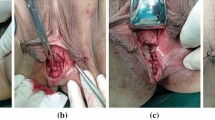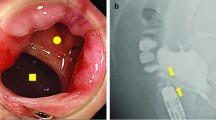Purpose
Surgical repair of rectovaginal fistula with an advancement flap has had suboptimal results. The existing literature documenting episioproctotomy as a surgical option in females with rectovaginal fistula or cloaca is limited. This study was designed to examine our experience with episioproctotomy in this group. Additionally we were interested in risk factors, which might predict failure.
Methods
All females who had repair of a rectovaginal fistula or cloaca with episioproctotomy from 1998 to 2004 were studied. Data were collected from chart review and telephone contact. This included demographics, body mass index, tobacco use, Crohn’s disease, previous surgery, and diverting stoma.
Results
Data were obtained from 42 females (mean age, 39.2 (range, 25–70) years). The mean follow-up was 37 (range, 2–84) months. Nine females had a cloaca and the rest had a rectovaginal fistula with an anterior sphincter defect. Eleven (all with anterior tissue) had recurrence of fistula. None with cloaca had recurrence. Eight of 11 recurrences occurred in females who had failed at least one previous repair. No variables that were studied significantly affected recurrence. Median (25th, 75th percentiles) postoperative Wexner incontinence scores for those with and without recurrence were 8 (7, 12) and 5 (2, 6) respectively.
Conclusions
Episioproctotomy is a successful technique for repair of rectovaginal fistula and cloaca. Incontinence score postoperatively were acceptable. It should be considered a first line of surgical treatment in those with a fistula that includes compromise of the anterior sphincter complex.
Similar content being viewed by others
References
T Sonoda T Hull MR Piedmonte VW Fazio (2002) ArticleTitleOutcomes of primary repair of anorectal and rectovaginal fistulas using the endorectal advancement flap Dis Colon Rectum 45 1622–1628 Occurrence Handle12473885 Occurrence Handle10.1007/s10350-004-7249-y
N Mizrahi SD Wexner O Zamora et al. (2002) ArticleTitleEndorectal advancement flap: are there predictors of failure? Dis Colon Rectum 45 1616–1621 Occurrence Handle12473884 Occurrence Handle10.1007/s10350-004-7248-z
CB Tsang RD Madoff WD Wong et al. (1998) ArticleTitleAnal sphincter integrity and function influences outcome in rectovaginal fistula repair Dis Colon Rectum 41 1141–1146 Occurrence Handle9749498 Occurrence Handle10.1007/BF02239436 Occurrence Handle1:STN:280:DyaK1cvhvF2htQ%3D%3D
TH Rockwood JM Church JW Fleshman et al. (2000) ArticleTitleFecal incontinence quality of scale: quality of life instrument for patients with fecal incontinence Dis Colon Rectum 43 9–17 Occurrence Handle10813117 Occurrence Handle10.1007/BF02237236 Occurrence Handle1:STN:280:DC%2BD3c3ntFahtw%3D%3D
JM Jorge SD Wexner (1993) ArticleTitleEtiology and management of fecal incontinence Dis Colon Rectum 36 77–97 Occurrence Handle8416784 Occurrence Handle10.1007/BF02050307 Occurrence Handle1:STN:280:ByyC3crnsVw%3D
SS Chew NA Reiger (2004) ArticleTitleTransperineal repair of obstetric-related anovaginal fistula Aust N Z J Obstet Gynaecol 44 68–71 Occurrence Handle15089873 Occurrence Handle10.1111/j.1479-828X.2004.00175.x
HM MacRae RS McLeod Z Cohen H Stern R Reznick (1995) ArticleTitleTreatment of rectovaginal fistulas that has failed previous repair attempts Dis Colon Rectum 38 921–925 Occurrence Handle7656738 Occurrence Handle10.1007/BF02049726 Occurrence Handle1:STN:280:ByqA1crlt10%3D
KS Khanduja A Padmanabhan BA Kerner WE Wise PS Aguilar (1999) ArticleTitleReconstruction of rectovaginal fistula with sphincter disruption by combining rectal mucosal advancement flap and anal sphincteroplasty Dis Colon Rectum 42 1432–1437 Occurrence Handle10566531 Occurrence Handle10.1007/BF02235043 Occurrence Handle1:STN:280:DC%2BD3c%2FjtVyjtQ%3D%3D
Author information
Authors and Affiliations
Electronic Supplementary Material
(MPG 45.1 MB)
About this article
Cite this article
Hull, T.L., Bartus, C., Bast, J. et al. Success of Episioproctotomy for Cloaca and Rectovaginal Fistula. Dis Colon Rectum 50, 97–101 (2007). https://doi.org/10.1007/s10350-006-0790-0
Published:
Issue Date:
DOI: https://doi.org/10.1007/s10350-006-0790-0




